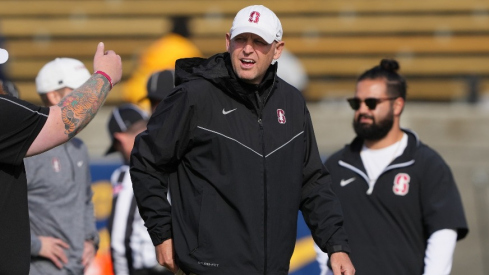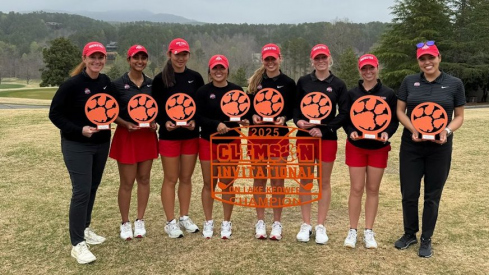
With the college football season less than 100 days away, it is a good opportunity to analyze the schemes of various Big Ten and National Title contenders for 2013. This week I will start with the team everyone is chasing--the Alabama Crimson Tide and its offensive scheme.
An Ode to the Hogs
The Crimson Tide offense utilizes a pro-style approach that is similar to most NFL offenses. Doug Nussmeier is 'Bama's offensive coordinator, a position previously filled by Jim McElwain during Saban's first two national championships. Both are descendants of the pro-style one-back coaching tree that stretches back to Don Coryell, Joe Gibbs, and Dennis Erickson.
As I previously discussed, the one-back offense is predicated upon mini-series--a run or a pass play protected by one or two 'constraint' plays such as a play action pass or screen. The system is versatile, in that it permits multiple personnel groupings, allowing an offense to both feature a tailback on downhill run plays as well as threaten a defense with four immediate vertical pass threats.
It is thus well suited to modern football's emphasis on a conceptual passing game, that being pass patterns that are put together to purposefully stretch the defense horizontally or vertically in a particular segment of the field, providing the offense more receivers than the defense has pass defenders in that area.

Alabama's offense, however, is more run-heavy than its NFL counterparts. Under Saban Alabama has featured a particular brand of the one-back offense--the use of multiple tight ends to create a downhill, power run game.
The Tide's base run play is inside zone, either from under center or the pistol. With inside zone, the offensive line will take an aggressive half step to the play side. If a lineman is covered (has a defensive lineman over him), he is responsible for blocking him to the playside shoulder. If uncovered, a lineman combo blocks to the play side with the nearest covered teammate.
Once a double team is established between the two offensive lineman, one of the two linemen combo blockers will come off onto the linebacker in their area. By making an offensive lineman responsible for an area rather than a man and having the linemen work in tandem, zone runs allows an offense to better account for the myriad of blitzes and stunts used by modern defenses. Zone run plays are thus ubiquitous for both pro-style and spread teams.
From the I position, the tailback will aim for the outside foot of the front side guard. He presses the hole and then 'runs to daylight,' hitting the play wherever an opening appears. 'Bama will often use their second tight end or H-back to seal block the backside edge, creating a natural cutback angle.
Once a team begins to overplay inside zone, the Tide will employ either outside zone or counter trey. With counter-trey the running back takes an initial inside zone step but cuts back and takes the hand-off following a pulling guard and H-back.
The blocking scheme is power-O blocking--the front side blocks down while the backside guard and back kick out and lead through the hole, creating angles at the point of attack. 'Bama often likes running these plays from shotgun to catch a defense flat-footed.
These base run plays constitute the core of Alabama's offense. The Crimson Tide use the run to set up other aspects and will rely upon running between the tackles until an opposing team can stop it. Saban likes employing massive, athletic offensive lines and physical, one-cut tailbacks to make it go.
The Crimson Tide's ability to run the football with zone and counter trey does not necessarily resemble an NFL team today. It is instead a throwback to another famous one-back team--the 1980's Washington Redskins under Gibbs featuring John Riggins and the 'Hogs.
Wear you down then look to strike
The Tide's passing game is fairly straightforward and is predicated upon the opportunities created by running the football. The Alabama passing game can largely be boiled down to two concepts. The Tide like to use short, quick throws such as spacing in their dropback pass game.
Alabama then looks to throw the football down the field off play-action, employing pass patterns such as four verticals, deep crossing, and post-corner routes. This short/long dichotomy is reminiscent of Pete Carroll's USC teams, reflective of Nussmeier's time at Washington with Steve Sarkisian.
Alabama is able to effectively push the football down field through a combination of holes created by defenses overly concerned with the Crimson Tide running attack and superior athletic talent. The 'Bama offense can stall when they are unable to effectively run the football because they are not designed to rely upon a drop back ball, control passing attack. They are instead looking to use the passing game for big plays.
Reflecting this tenet, Alabama under Saban has tended to have 'game managers' at QB -- players who can make throws but more importantly will make smart decisions and not undermine the ball control, defensive minded approach.
Flip the Script?
Saban's philosophic approach to offensive football makes the 2013 Crimson Tide an interesting unit to watch. Alabama's returning strength is QB AJ McCarron and a wide receiver corps led by Amari Cooper. McCarron has demonstrated the ability to get the football down field and make key throws. T.J. Yeldon returns off a 1,000 yard freshman season and in my opinion may be the most talented running back Saban has had at Alabama, including Heisman Trophy winner Mark Ingram and Trent Richardson.
But the 'Bama coaching staff faces no small task in replacing three starters from its offensive line, including top-15 picks Chance Warmack and DJ Fluker, and Remington winner Barrett Jones. The level of play by the Crimson Tide offensive line in 2012 cannot be understated. They were a dominant unit and the clear strength of the Alabama offense. When in doubt, the Crimson Tide could generally road-grade through their competition. The offensive line usually provided McCarron ample time to throw vertically off play action.
As such, Alabama's number of returning starters understates the challenge the coaching staff faces in reloading its offense. How Alabama fills those spots alongside pre-season All American candidate LT Cyrus Kouandjio remains to be seen.
The question becomes how does Nussmeier and his staff implement a strategic framework for this group. Does the coaching staff become more of a pass-first squad, placing more responsibility upon McCarron? Or do they simply reload up front and continue with the same script that has won Saban and company three national championships in four years? This debate will be one of the interesting story lines of the early 2013 season.

